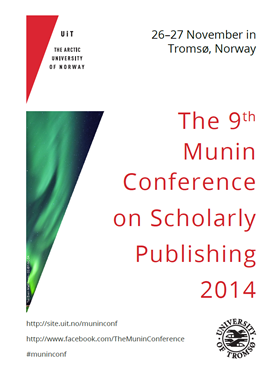New directions in scholarly publishing: journal articles beyond the present
DOI:
https://doi.org/10.7557/5.3228Keywords:
munin conference 2014Abstract
>> See video of presentation (28 min.)
The primary goal of scholarly communication is improving human knowledge and sharing is the key to achieve this goal: sharing ideas, sharing methodologies, sharing of results, sharing data, information and knowledge. Although the concept of sharing applies to all phases of scholarly communication, most often the only visible part is the final publication, with the journal article as a most common type. The traditional characteristics of the present journals allow only limited possibilities for sharing the knowledge. Basic functions, registration, dissemination, certification, and storage, are still present but they are no more effective in the network environment. Registration is too slow, there are various barriers to dissemination, certification system has many shortcomings, and used formats are not suitable for the long term preservation and storage. Although the journals today are digital and various powerful technologies are available, they are still focused on their unaltered printed versions. This presentation will discuss possible evolution of journal article to become more compliant with users' needs and to enable “the four R’s of openness” – reuse, redistribute, revise and remix (Hilton, Wiley, Stein, & Johnson, 2010).
Several aspects of openness will be presented and discussed: open access, open data, open peer review, open authorship, and open formats. With digital technology which has become indispensable in the creation, collection, processing and storage of data in all scientific disciplines the way of conducting scientific research has changed and the concept of "data-driven science" has been introduced (Ware & Mabe, 2009). Sharing research data enhances the capabilities of reproducing the results, reuse maximizes the value of research, accelerating the advancement of science, ensuring transparency of scientific research, reducing the possibility of bias in the interpretation of results and increasing the credibility of published scientific knowledge. The open peer review can ensure full transparency of the entire process of assessment and help to solve many problems in the present scholarly publishing. Through the process of the open peer review each manuscript can be immediately accessible, reviewers can publicly demonstrate their expertise and could be rewarded, and readers can be encouraged to make comments and views and to become active part of the scholarly communication process. The trend to to describe the author's contribution is also present, which will certainly lead to a reduced number of “ghost”, "guest" and "honorary" authors, and will help to establish better standards for author’s identification.
Various web technologies can be used also for the semantic enhancement of the article. One of the most important aspects of semantic publication is the inclusion of the research data, to make them available to the user as an active data that can be manipulated. It is possible to integrate data from external sources, or to merge the data from different resources (data fusion) (Shotton, 2012), so the reader can gain further understanding of the presented data. Additional options provide merging data from different articles, with the addition of the component of time. Other semantic enhancement can include enriched bibliography, interactive graphical presentations, hyperlinks to external resources, tagged text, etc.
Instead of mostly static content, journals can offer readers dynamic content that includes multimedia, "living mathematics", “executable articles”, etc. Videos highlighting critical points in the research process, 3D representations of chemical compounds or art works, audio clips with the author's reflections and interviews, and animated simulations or models of ocean currents, tides, temperature and salinity structure, can became soon common part of every research article. The diversity of content and media, operating systems (GNU / Linux, Apple Mac OSX, Microsoft Windows), and software tools that are available to researchers, suggests the usage of the appropriate open formats. Different formats have their advantages and disadvantages and it would be necessary to make multiple formats available, some of which are suitable for "human" reading (including printing on paper), and some for machine reading that can be used by computers without human intervention. Characteristics and possibilities of several formats will be discussed, including XML as the most recommended format, which can enable granulate document structure as well as deliver semantics to the human reader or to the computer.
Literature:
Hilton, J. I., Wiley, D., Stein, J., & Johnson, A. (2010). The Four R’s of Openness and ALMS Analysis: Frameworks for Open Educational Resources. Open Learning: The Journal of Open, Distance and E-Learning, 25(1), 37–44. doi:10.1080/02680510903482132
Shotton, D. (2012). The Five Stars of Online Journal Articles - a Framework for Article Evaluation. D-Lib Magazine, 18(1/2), 1–16. doi:10.1045/january2012-shotton
Ware, M., & Mabe, M. (2009). The stm report (p. 68).









